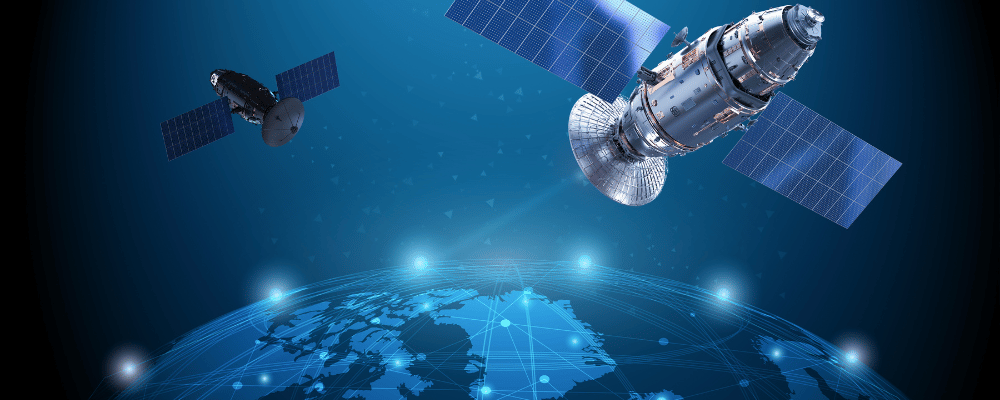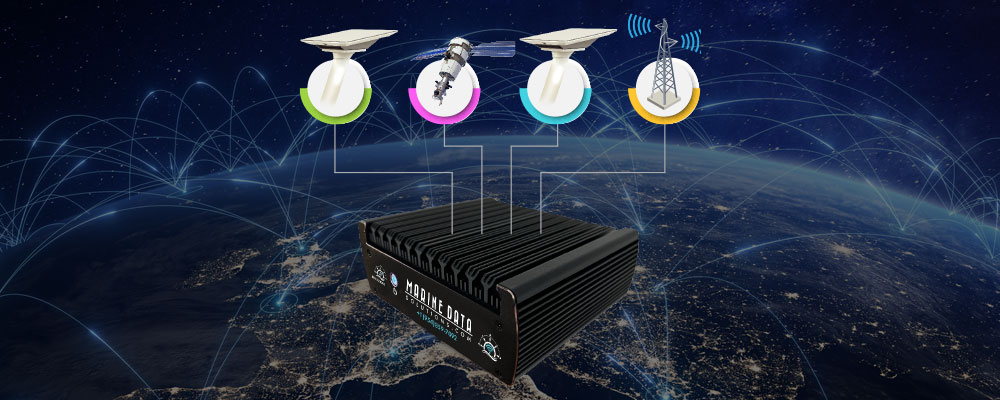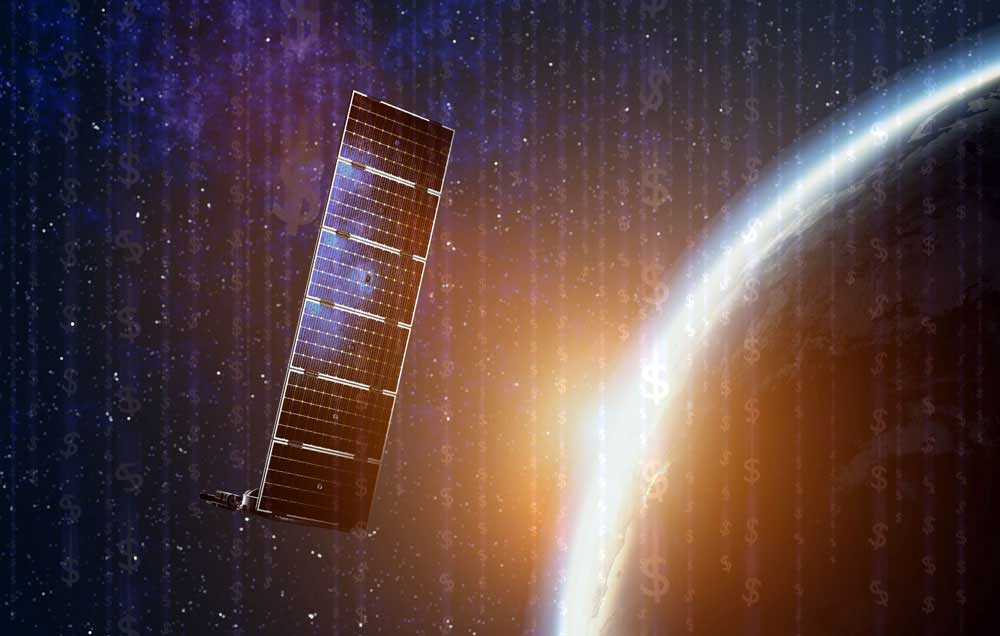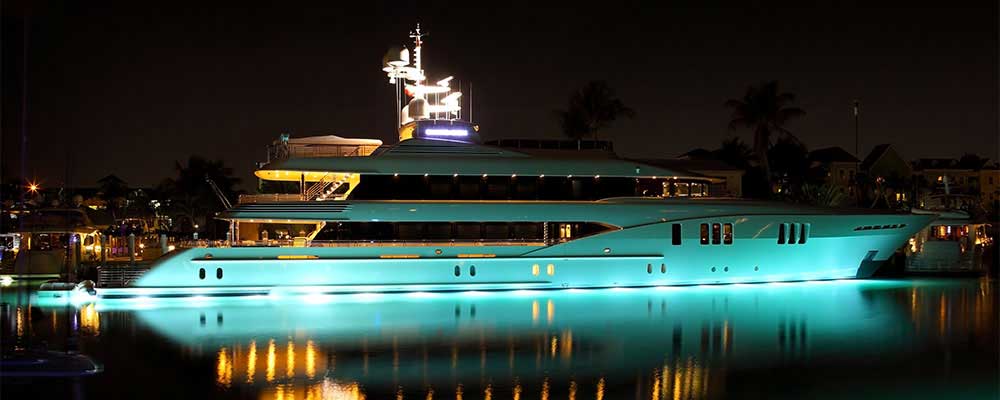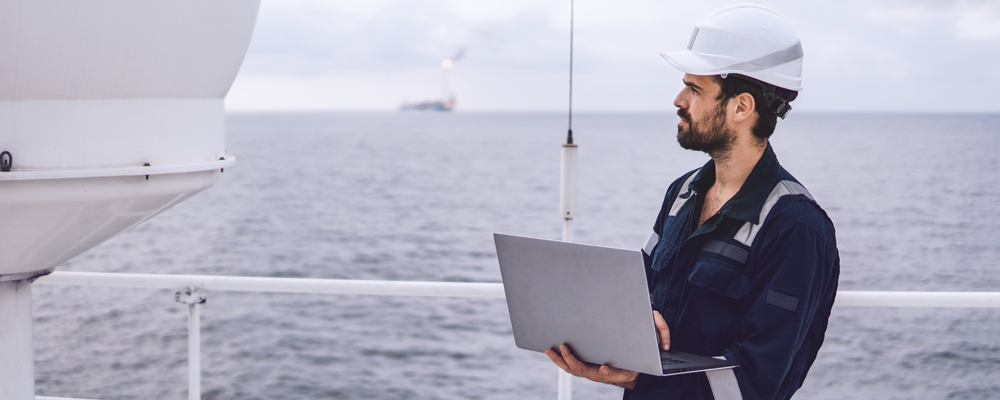blog
Exploring the Latest Innovations in Marine Communication
In the fast-paced world of luxury yachting, the pursuit of excellence never ceases, especially in the realm of onboard electronics. Today, the marine electronic landscape is witnessing a transformative era, largely influenced by the advent of cutting-edge technologies such as Starlink, 5G, and the MDS Blender. These innovations are not just altering the way we approach yacht design; they are revolutionizing the way in which communication is handled on the high seas.
A New Era of Connectivity: The MDS Blender Revolution
The MDS Blender is changing the way vessels manage their network connectivity. This innovative device provides each vessel with ease and efficiency in connectivity management. With an intuitive graphical user interface, the MDS Blender simplifies the complexities of network, connection, and device management, granting users a comprehensive 360-degree overview of their onboard connectivity.
Transitioning to LEO Sat: Navigating the Future of Marine Communication
In the vast and ever-evolving maritime industry, the transition from traditional Geostationary Earth Orbit (GEO) satellite systems to the revolutionary Low Earth Orbit (LEO Sat) systems like Starlink, OneWeb, and Project Kuiper marks a significant shift. This blog category aims to address the pain points and opportunities surrounding this transition, providing insights and updates on the latest developments in LEO Sat technology.
A Deep Dive into 5G: Speed, Reliability, and Beyond
Our new 5G USA yacht internet airtime plans have been meticulously designed to cater to the unique needs of yachts, offering not only price competitiveness but also superior performance in several key areas when compared to traditional satellite internet solutions. This category delves into the intricacies of 5G technology, exploring its impact on maritime communication and connectivity.
Enhancing Internet Connectivity at Sea with the MDS Blender
With over 35 years of experience in designing electronic systems for large yachts, our goal is to ensure that our clients enjoy unparalleled internet connectivity, seamlessly blending luxury with the highest standards of functionality. The integration of the MDS Blender represents a significant leap forward in achieving this goal, providing vessels with reliable, high-speed internet access no matter where they are on the globe.
Exploring the Latest Innovations in Marine Communication
In the dynamic world of luxury yachting, the quest for perfection is perpetual, especially in the domain of onboard electronics. Today, the marine electronic landscape is undergoing a transformative phase, driven by cutting-edge technologies like Starlink, 5G, and the MDS Blender. These innovations aren’t merely reshaping yacht design; they’re revolutionizing communication protocols on the open seas.
A New Era of Connectivity: The MDS Blender Revolution
The MDS Blender is heralding a paradigm shift in how vessels manage their network connectivity. This groundbreaking device offers unparalleled ease and efficiency in connectivity management. Equipped with an intuitive graphical user interface, the MDS Blender streamlines the intricacies of network, connection, and device management, empowering users with a comprehensive overview of their onboard connectivity.
Transitioning to LEO Sat: Navigating the Future of Marine Communication
In the expansive and ever-evolving maritime landscape, the transition from traditional Geostationary Earth Orbit (GEO) satellite systems to revolutionary Low Earth Orbit (LEO Sat) systems like Starlink, OneWeb, and Project Kuiper signifies a monumental change. This blog category is dedicated to addressing the challenges and opportunities associated with this transition, offering insights and updates on the latest advancements in LEO Sat technology.
A Deep Dive into 5G: Speed, Reliability, and Beyond
Our meticulously crafted 5G USA yacht internet airtime plans are tailored to meet the distinctive needs of yachts, delivering not just competitive pricing but also unparalleled performance across various key areas compared to conventional satellite internet solutions. This category delves deep into the nuances of 5G technology, exploring its transformative impact on maritime communication and connectivity.
Enhancing Internet Connectivity at Sea with the MDS Blender
With over three decades of experience in crafting electronic systems for large yachts, our mission is to ensure that our clients experience unmatched internet connectivity, seamlessly blending luxury with uncompromising functionality. The integration of the MDS Blender represents a monumental leap towards achieving this objective, furnishing vessels with dependable, high-speed internet access regardless of their location on the globe.
Exploring the Latest Innovations in Marine Communication
In the dynamic world of luxury yachting, the quest for perfection is perpetual, especially in the realm of onboard electronics. Today, the marine electronic landscape is undergoing a transformative era, largely influenced by cutting-edge technologies such as Starlink, 5G, and the MDS Blender. These innovations are not just altering the way we approach yacht design; they are revolutionizing the way in which communication is handled on the high seas.
A New Era of Connectivity: The MDS Blender Revolution
The MDS Blender is changing the way vessels manage their network connectivity. This innovative device provides each vessel with ease and efficiency in connectivity management. With an intuitive graphical user interface, the MDS Blender simplifies the complexities of network, connection, and device management, granting users a comprehensive 360-degree overview of their onboard connectivity.
Transitioning to LEO Sat: Navigating the Future of Marine Communication
In the vast and ever-evolving maritime industry, the transition from traditional Geostationary Earth Orbit (GEO) satellite systems to the revolutionary Low Earth Orbit (LEO Sat) systems like Starlink, OneWeb, and Project Kuiper marks a significant shift. This blog category aims to address the pain points and opportunities surrounding this transition, providing insights and updates on the latest developments in LEO Sat technology.
A Deep Dive into 5G: Speed, Reliability, and Beyond
Our new 5G USA yacht internet airtime plans have been meticulously designed to cater to the unique needs of yachts, offering not only price competitiveness but also superior performance in several key areas when compared to traditional satellite internet solutions. This category delves into the intricacies of 5G technology, exploring its impact on maritime communication and connectivity.
Enhancing Internet Connectivity at Sea with the MDS Blender
With over 35 years of experience in designing electronic systems for large yachts, our goal is to ensure that our clients enjoy unparalleled internet connectivity, seamlessly blending luxury with the highest standards of functionality. The integration of the MDS Blender represents a significant leap forward in achieving this goal, providing vessels with reliable, high-speed internet access no matter where they are on the globe.
Join us on a voyage of discovery through the vast expanse of maritime internet technology with Marine Data Solutions’ blog as your trusted guide. Our blog serves as a lighthouse, illuminating the path to seamless connectivity and optimal performance for vessels of all sizes and types.
Embark on a journey of exploration as we navigate the intricate waters of satellite internet technology. From understanding the differences between geostationary and low Earth orbit satellites to exploring the latest advancements in antenna technology, we provide a comprehensive overview of the tools and techniques available to enhance connectivity at sea.
Chart a course towards the future with our insights into the integration of 5G networks into maritime environments. Discover how 5G’s high-speed, low-latency capabilities are revolutionizing onboard communication, enabling real-time data transfer, and enhancing operational efficiency. With our guidance, you can navigate the complexities of 5G integration and leverage its full potential to stay connected wherever your adventures take you.
Drop anchor and delve into our treasure trove of tips and tricks for optimizing your vessel’s connectivity setup. From fine-tuning network configurations to troubleshooting common issues, we provide practical advice to help you navigate the challenges of maritime internet technology with confidence. With our expertise at your side, you can ensure smooth sailing and reliable communication on every voyage.
Stay informed about the latest trends and developments shaping the maritime industry with our in-depth analysis and commentary. From regulatory changes to emerging technologies, we keep you up-to-date on the forces driving innovation and transformation in maritime connectivity. Join us as we navigate the ever-changing currents of the industry, providing you with the knowledge and insights you need to stay ahead of the curve.
Engage with a community of fellow sailors and industry experts through our interactive forums and discussion groups. Share your experiences, exchange ideas, and learn from others who share your passion for maritime internet technology. Together, we can navigate the digital seas and overcome challenges, forging connections and sharing knowledge to enhance connectivity at sea.
Prepare for the challenges and opportunities of tomorrow with our forward-thinking insights and predictions for the future of maritime connectivity. From the adoption of autonomous vessels to the potential of emerging technologies like artificial intelligence and blockchain, we explore the trends and developments that will shape the maritime landscape of the future. Join us as we navigate towards a future where connectivity is seamless, reliable, and accessible to all who sail the seas.
Subscribe to our blog today and embark on a voyage of discovery with Marine Data Solutions. Together, we’ll navigate the seas of maritime internet technology, charting a course towards a future where connectivity knows no bounds. Whether you’re a seasoned sailor or a curious newcomer, our blog has something for everyone who shares a passion for innovation and excellence at sea.
Set sail with Marine Data Solutions’ blog and embark on a journey through the ever-evolving realm of maritime internet technology. Our blog stands as a beacon of knowledge, guiding you through the intricate waters of satellite internet, 5G integration, and innovative connectivity solutions tailored specifically for maritime needs.
Venture into uncharted territory as we navigate the complexities of satellite internet technology. From exploring the various satellite constellations to understanding signal propagation and beamforming, we provide a comprehensive overview of the tools and techniques that drive connectivity at sea. With our guidance, you’ll gain a deeper understanding of how satellite technology can revolutionize communication aboard your vessel.
Navigate the seas of innovation with our insights into the integration of 5G networks into maritime environments. Discover the potential of 5G to deliver lightning-fast speeds, ultra-low latency, and seamless connectivity for vessels of all sizes. We’ll guide you through the process of incorporating 5G into your onboard communication infrastructure, ensuring that you stay connected and productive on every voyage.
Drop anchor and dive into our treasure trove of tips and strategies for optimizing your vessel’s connectivity setup. Whether you’re fine-tuning antenna placement, optimizing network configurations, or troubleshooting connectivity issues, we provide practical advice to help you navigate the challenges of maritime internet technology with confidence. With our expertise at your disposal, you’ll be well-equipped to overcome any obstacle and ensure smooth sailing on the digital seas.
Stay abreast of the latest trends and developments shaping the maritime industry with our in-depth analysis and commentary. From regulatory changes to emerging technologies, we keep you informed of the forces driving innovation and transformation in maritime connectivity. Join us as we navigate the currents of change, providing you with the knowledge and insights you need to stay ahead of the curve.
Engage with a community of fellow sailors and industry experts through our interactive forums and discussion groups. Share your experiences, exchange ideas, and learn from others who share your passion for maritime internet technology. Together, we can navigate the challenges and opportunities of the digital age, forging connections and sharing knowledge to enhance connectivity at sea.
Prepare for the future of maritime connectivity with our forward-thinking insights and predictions. From the rise of autonomous vessels to the potential of emerging technologies like AI and IoT, we explore the trends and developments that will shape the maritime landscape of tomorrow. Join us as we chart a course towards a future where connectivity is seamless, reliable, and accessible to all who sail the seas.
Subscribe to our blog today and join us on a voyage of discovery with Marine Data Solutions. Together, we’ll navigate the seas of maritime internet technology, charting a course towards a future where connectivity knows no bounds. Whether you’re a seasoned sailor or a curious newcomer, our blog has something for everyone who shares a passion for innovation and excellence at sea.
Continue your exploration of maritime internet technology with Marine Data Solutions’ blog, where we invite you to dive deeper into the intricacies of connectivity at sea. Our blog is your compass in the vast ocean of information, guiding you through the latest trends, technologies, and best practices for optimizing your vessel’s communication infrastructure.
Embark on a voyage of discovery as we navigate the landscape of satellite internet technology. From the mechanics of signal transmission to the advantages of different satellite constellations, we provide a comprehensive overview of the options available to enhance connectivity on board. Gain insights into how satellite technology can improve communication, safety, and efficiency for maritime operations.
Chart a course towards the future with our exploration of 5G integration in maritime environments. Discover how this next-generation technology is revolutionizing onboard communication with its high-speed data transfer and low latency. Learn how to leverage 5G to enhance crew welfare, streamline operations, and enable new applications for navigation, monitoring, and entertainment.
Introducing Marine Communication Security: Safeguarding Data on the High Seas
As the reliance on advanced communication technologies grows in the maritime industry, so does the importance of ensuring the security of data transmitted and received aboard vessels. This category explores the latest advancements in marine communication security, including encryption protocols, intrusion detection systems, and secure data transmission methods, aimed at protecting sensitive information from potential cyber threats and unauthorized access.
Harnessing AI for Smart Navigation and Communication
Artificial Intelligence (AI) is reshaping the landscape of marine communication and navigation, offering innovative solutions to improve efficiency, safety, and decision-making processes onboard yachts. This segment delves into the applications of AI in maritime communication systems, such as predictive analytics for weather routing, autonomous vessel control, and adaptive communication protocols, paving the way for smarter and more responsive yachting experiences.
Integrating IoT for Enhanced Vessel Management and Communication
The Internet of Things (IoT) is revolutionizing the way vessels are monitored, managed, and communicated with, by enabling seamless connectivity between onboard systems, sensors, and external networks. This blog category explores the integration of IoT technologies in marine communication systems, showcasing real-world applications such as remote diagnostics, predictive maintenance, and asset tracking, aimed at optimizing vessel performance and enhancing onboard experiences for crew and passengers alike.
Empowering Crew Collaboration with Unified Communication Platforms
Effective communication among crew members is crucial for ensuring smooth operations and emergency response aboard yachts. Unified Communication (UC) platforms offer comprehensive solutions for integrating voice, video, messaging, and data-sharing capabilities into a single interface, facilitating seamless collaboration and decision-making processes onboard. This segment examines the benefits of UC platforms in enhancing crew communication, coordination, and productivity, ultimately contributing to a safer and more efficient yachting environment.
Exploring Blockchain Applications in Maritime Communication and Logistics
Blockchain technology holds immense potential for revolutionizing various aspects of the maritime industry, including communication, supply chain management, and logistics. This category delves into the applications of blockchain in enhancing transparency, security, and efficiency in maritime communication and logistics processes, such as cargo tracking, document verification, and transaction settlements, ultimately streamlining operations and reducing administrative overhead for stakeholders across the maritime ecosystem.
Next-Generation Weather Forecasting for Safer Navigation
Accurate weather forecasting plays a critical role in ensuring the safety and efficiency of maritime operations, particularly for luxury yachts traversing vast oceans. This segment focuses on the latest advancements in weather forecasting technologies, including high-resolution modeling, machine learning algorithms, and real-time data analytics, aimed at providing yacht captains and crew with timely and reliable weather information to optimize route planning, avoid adverse conditions, and enhance onboard safety and comfort.
Revolutionizing Onboard Entertainment and Communication Experiences
In today’s connected world, passengers aboard luxury yachts expect seamless access to entertainment and communication services comparable to those available on land. This blog category explores the latest trends and innovations in onboard entertainment and communication systems, such as immersive audiovisual experiences, satellite TV streaming, and high-speed internet connectivity, designed to enhance the overall guest experience and satisfaction while cruising the open seas.
Navigating Regulatory Compliance in Maritime Communication
The maritime industry is subject to a complex web of regulations and standards governing communication equipment, frequencies, and protocols to ensure safety, security, and environmental protection. This segment examines the regulatory landscape impacting maritime communication, including international conventions, flag state requirements, and industry guidelines, and provides guidance on achieving compliance through proper equipment selection, installation, and maintenance practices, thereby mitigating risks and liabilities for yacht owners and operators.
Introducing Quantum Communication for Unhackable Maritime Networks
Quantum communication harnesses the principles of quantum mechanics to achieve secure and unhackable communication channels, making it an ideal solution for safeguarding sensitive data transmitted over maritime networks. This category explores the potential applications of quantum communication in the maritime industry, including secure data transmission, encrypted messaging, and quantum key distribution (QKD), offering unparalleled levels of security and privacy for yacht owners, operators, and crew members.
Advancing Maritime Search and Rescue Operations with AI and Satellite Communication
Search and rescue operations in maritime environments require timely and accurate coordination between rescue teams, vessels in distress, and emergency response agencies. This segment highlights the role of AI-powered algorithms and satellite communication technologies in improving the effectiveness and efficiency of maritime search and rescue operations, enabling rapid deployment of resources, real-time situational awareness, and enhanced communication capabilities to save lives and mitigate risks at sea.
Empowering Environmental Monitoring and Conservation Efforts through Marine Communication
Marine ecosystems are facing unprecedented challenges from pollution, climate change, and habitat degradation, necessitating proactive monitoring and conservation efforts to safeguard marine biodiversity and ecosystem health. This blog category explores how marine communication technologies, such as underwater sensors, satellite imagery, and remote sensing platforms, are being leveraged to monitor environmental parameters, track marine species, and support conservation initiatives, fostering sustainable stewardship of the oceans for future generations.
Fostering International Collaboration for Maritime Communication Standards
Effective communication among vessels, ports, and maritime authorities relies on standardized protocols and interoperable systems to ensure seamless information exchange and coordination across international borders. This segment examines the importance of fostering international collaboration and consensus-building efforts to develop common standards and best practices for maritime communication, facilitating interoperability, efficiency, and safety in global maritime operations and navigation.
Navigating Cybersecurity Challenges in Maritime Communication Systems
As maritime communication systems become increasingly digitized and interconnected, they also become more vulnerable to cyber threats such as hacking, malware, and ransomware attacks. This category delves into the cybersecurity challenges facing maritime communication systems, including vulnerabilities in onboard networks, the potential impact of cyber attacks on vessel operations, and strategies for mitigating risks and enhancing cybersecurity resilience through robust defense mechanisms, employee training, and proactive threat intelligence sharing initiatives.
Emerging Trends in Satellite Communication for Maritime Connectivity
Satellite communication plays a crucial role in providing reliable connectivity for maritime vessels, enabling voice, data, and internet services even in remote regions beyond the reach of terrestrial networks. This segment explores the latest trends and innovations in satellite communication technology for maritime connectivity, including advancements in satellite constellations, antenna systems, and bandwidth optimization techniques, aimed at delivering faster speeds, lower latency, and expanded coverage areas to meet the growing demands of modern yachts and maritime operators.
Revolutionizing Crew Welfare and Communication with Virtual Reality (VR) Technology
Virtual Reality (VR) technology has the potential to transform the way crew members interact with each other, receive training, and maintain mental well-being during long voyages at sea. This blog category investigates the applications of VR technology in enhancing crew welfare and communication onboard yachts, such as immersive training simulations, virtual social environments, and interactive entertainment experiences, fostering a sense of camaraderie, engagement, and mental resilience among crew members while at sea.
Exploring the Role of Blockchain in Maritime Supply Chain Management
Blockchain technology offers unprecedented transparency, traceability, and efficiency in supply chain management, making it a valuable tool for optimizing maritime logistics and cargo operations. This segment examines how blockchain can streamline various aspects of maritime supply chain management, including cargo tracking, customs clearance, and freight payments, by providing a decentralized and tamper-proof ledger that ensures trust and accountability among stakeholders, ultimately reducing costs, minimizing delays, and enhancing overall supply chain resilience in the maritime industry.
Analyzing the Impact of Remote Operations on Maritime Communication
Remote operations technologies enable vessel operators to monitor and control onboard systems from shore-based facilities, thereby reducing the need for onboard crew and optimizing operational efficiency. This category delves into the implications of remote operations on maritime communication, including the requirements for reliable remote connectivity, real-time data transmission, and cybersecurity considerations, as well as the potential benefits and challenges of transitioning to remote-operated vessel models in the maritime industry.
Unlocking the Potential of Augmented Reality (AR) for Maritime Navigation
Augmented Reality (AR) technology overlays digital information and graphics onto the real-world environment, offering new opportunities for enhancing situational awareness and navigation capabilities onboard vessels. This segment explores the applications of AR technology in maritime navigation, such as heads-up displays for displaying navigational charts and hazards, augmented reality overlays for visualizing vessel trajectories and collision avoidance, and AR-based training simulations for improving crew proficiency in navigation tasks, ultimately contributing to safer and more efficient maritime operations.
Embracing Sustainable Energy Solutions for Off-Grid Maritime Communication
Off-grid maritime communication solutions rely on sustainable energy sources such as solar, wind, and hydro power to power onboard communication systems and electronics, reducing reliance on fossil fuels and minimizing environmental impact. This blog category investigates the latest developments in sustainable energy solutions for off-grid maritime communication, including solar-powered satellite terminals, wind-powered generators, and energy-efficient communication devices, aimed at promoting environmental sustainability and reducing carbon emissions in the maritime sector.
Navigating Regulatory Challenges in Autonomous Maritime Communication
Autonomous vessels equipped with advanced communication systems and artificial intelligence algorithms have the potential to revolutionize the maritime industry by improving safety, efficiency, and sustainability. This segment examines the regulatory challenges and legal frameworks governing autonomous maritime communication, including international conventions, flag state regulations, and liability considerations, and discusses the steps needed to address regulatory gaps and facilitate the safe deployment and operation of autonomous vessels in global waters.
Optimizing Bandwidth Management for Maritime Communication
Bandwidth management is crucial for ensuring efficient and reliable communication onboard vessels, especially in environments where bandwidth is limited or costly. This category explores strategies and technologies for optimizing bandwidth utilization in maritime communication systems, such as bandwidth prioritization, data compression techniques, and Quality of Service (QoS) controls, aimed at maximizing the efficiency of data transmission while minimizing latency and costs for yacht owners and operators.
Enhancing Maritime Safety through Collaborative Communication Platforms
Collaborative communication platforms enable real-time information sharing and coordination among vessels, ports, and maritime authorities, improving situational awareness and safety at sea. This segment delves into the benefits of collaborative communication platforms in enhancing maritime safety, including features such as instant messaging, shared situational awareness tools, and collaborative decision-making interfaces, and examines case studies and best practices for implementing these platforms in the maritime industry.
Addressing Connectivity Challenges in Polar Regions
Polar regions present unique challenges for maritime communication due to extreme weather conditions, remote locations, and limited infrastructure. This blog category discusses the connectivity challenges faced by vessels operating in polar regions and explores solutions for improving communication reliability and coverage, such as satellite constellations optimized for polar orbits, ruggedized communication equipment designed for harsh environments, and hybrid communication networks combining satellite, terrestrial, and high-frequency radio systems.
Harnessing Edge Computing for Low-Latency Maritime Applications
Edge computing technology brings computational power closer to the point of data generation, reducing latency and improving responsiveness for maritime applications that require real-time data processing and analysis. This segment examines the potential applications of edge computing in maritime communication, such as onboard data analytics, predictive maintenance, and autonomous navigation systems, and discusses the benefits of edge computing architectures for enhancing operational efficiency and safety onboard yachts and commercial vessels.

